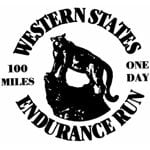 Ahead of the 2015 Western States 100, we speak with Stephanie Howe, Magdalenda Boulet, Michele Yates, and Meghan Arbogast. In case you’ve been living under a rock, Stephanie is the returning WS 100 champ. She will face solid competition in Magdalena, who will debut at the 100-mile distance here; Michele, who hopes to contend for the win; and Meghan, who is seeking her ninth top-10 finish.
Ahead of the 2015 Western States 100, we speak with Stephanie Howe, Magdalenda Boulet, Michele Yates, and Meghan Arbogast. In case you’ve been living under a rock, Stephanie is the returning WS 100 champ. She will face solid competition in Magdalena, who will debut at the 100-mile distance here; Michele, who hopes to contend for the win; and Meghan, who is seeking her ninth top-10 finish.
In the following interviews, Stephanie talks about the challenge of being a returning champion, Magda discusses her analytical approach to preparing for this race, Michele talks about her running life since becoming a mother, and Meghan shares her Western States passion.
You can jump immediately to interviews with:
Don’t forget to check out our full women’s preview as well as our other set of written interviews with Emma Roca, Pam Smith, Anita Ortiz, and Nicole Studer to see who these ladies will be racing.
Stephanie Howe

Stephanie Howe
iRunFar: Defending champ, really smooth race last year. How the heck can you improve or even expect to improve on that at 100 miles, a really challenging distance to ‘get right?’ What’s the internal dialogue that’s happening right now? That’s been happening the last couple months?
Stephanie Howe: I know, right? Last fall when I was planning my 2015 races, I wasn’t going to come back to Western States. I felt I had accomplished every goal I had set for myself and to come back would just be setting myself up for disappointment. So I planned my race schedule, which included Transvulcania, Lavaredo, and UTMB. The more I thought about it, the more it just didn’t seem right. I felt like I’d be missing out on something. So I discussed with my coach, Ian Torrence. After a few back-and-forth email exchanges, Ian wisely noted that he could tell how much Western States meant to me. Here I am.
I am drawn to Western States. To me it is the culmination of everything that I’ve worked toward as a runner. I don’t know what it is about States, but I get goosebumps just thinking about it. I am honored to have the opportunity to race again this year. To me, Western States is the most prestigious and iconic 100-mile race. My heart is full of pride as I think about my upcoming race. I equate this feeling to the World Series or Stanley Cup. (Or whatever your sport of choice… what’s football again?) Western States is my Stanley Cup.
Coming back, I am trying to remember the reason why I’m racing. Sure I’d love to place well again, but that’s not the most important thing to me. It’s been hard to keep that perspective as race day nears. So many people are asking me if I’m going to win, or they just want to talk about the result. I guess that’s normal, but it’s really not what I want to spend my energy focusing on. Going into the race with a big X on my back is going to be tough. I need to remember why I am racing and keep that mindset as the pre-race craziness begins. I want to be in this sport for a long time and I know I won’t always be winning races. Learning to check my ego and accepting that I did my very best, no matter what place I finish is part of maturing as a runner, and a person for that matter. In high school, we had these shirts for cross-country skiing that said “I did the best I could today” to wear after races. I wish I had that shirt to wear after States!
iRunFar: Last year’s WS 100 was your debut 100 miler. In my opinion, your greatest challenger is Magda Boulet, and she’s got that same question mark hovering over her this year. You proved that a combination of training and race-day smarts can overcome not having run the distance. You’ve run with Magda. You’ve seen her become a close study of the other ultramarathons she’s undertaken. What are your thoughts on competing with her? Do you think that competing with her will bring out the best in each of you? What are Magda’s strengths?
Howe: I don’t know Magda very well. We met and ran together one day of the Western States Memorial Weekend Training Runs in May. She is one of the nicest, sweetest people I’ve met. I respect her very much and look up to her as a runner. She has one impressive background! And, because she’s so nice I can’t help but want to see her succeed. I think she has been very smart in her approach to ultra races and I see a lot of the same traits in her that I possessed going into my first 100 miler.
Magda and I have only raced each other once, at The North Face 50 Mile in December, where she blew me out of the water. I don’t feel I ran to my potential that day due to illness, but excuses or not, she still solidly beat me. Since then I’ve had a few great fitness tests and feel like I’m back to myself again. But, I do agree that Magda is going to be tough.
I think competing together will bring out the best in both of us. I think we respect each other a great deal and will be racing ‘together’ rather than trying to beat each other down. I don’t think that’s Magda’s racing style. I know it’s not mine, so I think we will be on the same page.
iRunFar: Your educational background is in nutrition related to endurance activity. The science side of eating and running is something you really have dialed in. But ultra eating is still a bit of an experiment of one. Can you walk us through your race-day nutrition plan? And how do you adapt science theory to your own body?
Howe: My background in nutrition has been very helpful for me as a runner. I feel like over the past couple years I’ve really fueled well. This year, I’ve dialed it in even more and have nailed my nutrition at every race so far. It’s a pretty cool feeling! At Lake Sonoma this year my quads were trashed with 20 miles left to run. I was like “oh well” because, despite my hurting legs, my energy was great. I never got low energy the entire race because I fueled well.
I’ve talked about my fueling strategy many times, so it’s no secret what I do. For some reason, runners have a difficult time fueling properly. I don’t really understand it… it’s like people choose to fuel too little early on and then end up with stomach distress. In most cases, GI distress can be avoided by fueling early, often, and with the correct type of fuel.
It’s been fun for me to work with some fellow ultrarunners and see them thrive after dialing in their nutrition strategy. I have a few runners racing States this year. I can’t wait to see them put their new fueling to the test!
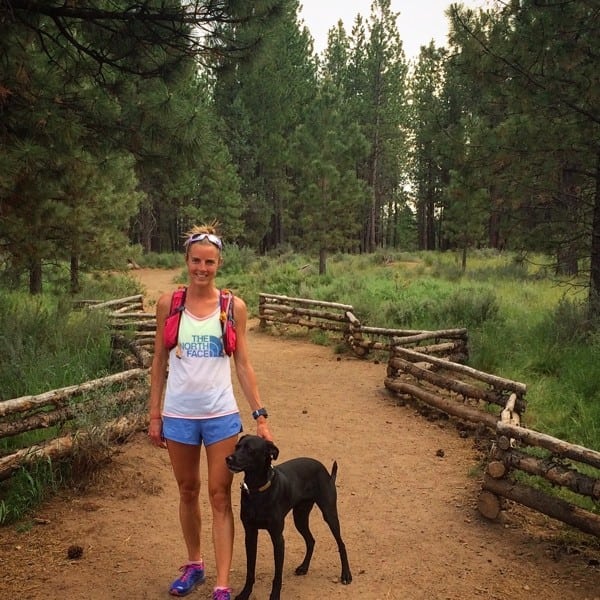
Stephanie with her dog, Riley. Photo: Zach Violett
iRunFar: Given the women who are racing this year, the mix of experience and background, have you given any thought to the racing dynamic? How it might play out? Who will rabbit the race? Who will be a late-race hunter? Anyone you think will just ‘be there’ start to finish?
Howe: I haven’t thought too much about others. I’m more concerned about running my own race. That was my strategy last year and it went pretty well. I will not start hard, and I will not surge early on. One hundred miles is still a long way to run! I’ll admit I’m still intimidated by the distance, which I think is healthy. Last year I took it easy at the start and had a great first couple hours chatting with friends and preparing for the long day. I don’t see any reason to change that. As Meghan Arbogast says, “The only race won in the first 50 miles, is a 50-mile race.” True story.
I do feel that some of the women will take it out too hard this year. I have raced Michele Yates a handful of times and I know she is aggressive from the start. I expect her to be way ahead at the top of Emigrant Pass. I expect some of the women will probably go with her, but it’s hard to know what others will do race day. I am going to try my hardest not to let others’ race tactics influence my plan. In a 50-mile race, I’d be tempted to keep contact or stay with the leaders, but 100 miles is a whole different beast.
Magdalena Boulet

Magdalena Boulet
iRunFar: What has made you decide you wanted to race 100 miles? When did it occur to you that, “Yes, this something I want to try.” It seems like it was not that long ago that we were talking to you before your first ultra. Leaps and bounds! What are you hoping to get out of the experience?
Magdalena Boulet: I have always been curious if one day I will have the guts to run a 100-mile race. After my pacing duties at WS 100 last year, I knew I wanted to experience something special and I knew I wanted to do my first 100-mile race at WS 100. The pure joy I witnessed on runners’ faces crossing the finish line last year was unreal and I really want to be a part of it.
iRunFar: In watching the way you approach races, I see that you’re a close study of what you’re going to undertake. You put in an extended training block. You train on the course. You ask questions of your peers. From where and who and how have you learned about racing Western States?
Boulet: I am a student of our sport and I take pride in my preparation process for sure, but I also want to learn ahead of time about what mistakes others have made so I don’t need to reinvent the wheel. I learn a great deal from my peers, but in the end I need to adapt to what works best for me. My confidence comes from the work I put in and I am grateful to many the local runners here who have been gracious to share their highs and lows with me. To name just a few people that I have surrounded myself with… Ian Sharman has been instrumental in helping me incorporate the key ingredients necessary in preparation for WS 100. I have been chasing Matt Laye, Brett Rivers, Dylan Bowman, and Gary Gellin up Mt. Tam each Wednesday at 6 a.m. My coworkers at GU have been inspiring and motivating me to chase this goal.
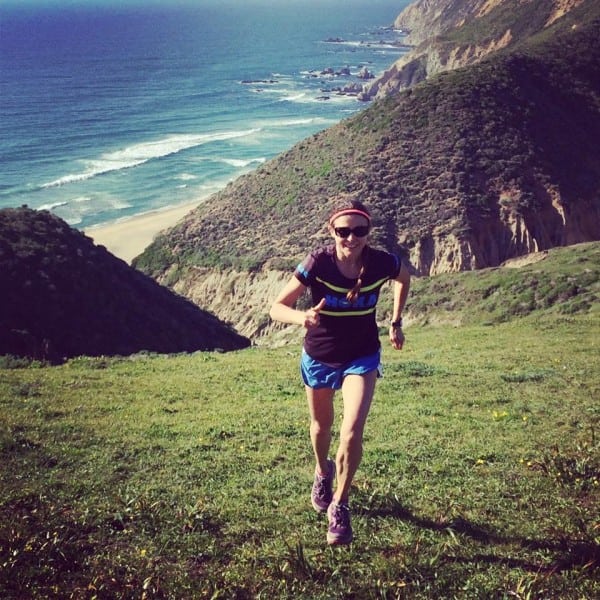
Magda in the Marin Headlands. Photo courtesy of Magdalena Boulet.
iRunFar: Last year, Stephanie Howe won WS 100 in her debut 100 miler. Does this fact give you any solace that it’s possible to overcome the ‘newbie’ factor with enough prep and race-day execution? What among your strengths will you be relying upon on race day? What traits do you know will be of special assistance to you in Western States’s unique conditions?
Boulet: It definitely is good to know that it’s possible to win on your first try; that is somewhat comforting. I think my biggest strength as a runner is that I don’t really give up… almost to a fault. There have been times when that part of me has gotten me in trouble. But I know in a 100 there will be rough patches where you’re not feeling great, and I feel like I’ll be able to push through and keep putting one foot in front of the other.
iRunFar: Your crew and pacers, talk about your team and what each person will physically and psychologically add to your race and experience at Western States.
Boulet: My pacer is Jason Hill. Jason has paced WS 100 multiple times and he will be pacing me the entire 38 miles. We both have something in common and that is keeping things really simple. I have enjoyed running with Jason for the past year when he lived in the Bay Area while he worked for HOKA. Jason moved up to Portland, Oregon last month so I have missed running with him and this will be a good time to catch up on life. I have two very special people in my life who will be crewing for me. My best friend Bridget Duffy has shown up at most of my adventures over the past decade. My other partner in crime will be Richie, my husband, who is my rock. It takes a strong man to handle a woman like me and I can always count on him having a plan B. Richie balances my super-optimistic perspective on life by keeping me honest and real. I definitely feel like I am in good hands.
Michele Yates

Michele Yates
iRunFar: Give us your big-picture thoughts on your running career over the last couple years. In 2013, you were on, on, on, every race, all the time. You had some health issues that affected your racing in early 2014 and then along came pregnancy, which tempered things as well. In your post-pregnancy comeback, performance-wise, it seems like you continue to trend back upward again. What has the journey of the last 2.5 or so years felt like to you?
Michele Yates: It sure has been a whirlwind of blessings and challenges! 2013 was when I started the ultra-trail scene and was loving every minute of it. I really just took it one race opportunity at a time and focused specifically on that particular race, then the next and the next… but all in all it was just FUN! In 2014 I was going for the 100-mile record at Rocky Racoon, however, and I had been experiencing some health issues during that training (although it was great training). Mainly, I would get really bad dizzy spells and still encountered some gut issues. I thought maybe I was just tired from training, but when I went down in the race, I knew there was something more medically wrong. Turned out that I have thyroid disease that hadn’t been diagnosed for some time. (I inherited it from my dad.) It’s co-existing Graves’ and Hashimoto’s. With Graves’ everything is elevated, with Hashimoto’s it plummets and there are days that I can’t even get out of bed let alone take care of Maya if it’s not controlled. So for me, life is a balancing act in more than one way.
Now that I have my thyroid SOMEWHAT under control, it’s obviously easier to focus on the other things in life. My daughter and family, my training and coaching. I can always tell when my thyroid starts acting up again though… dizzy spells are profound and I’m in tune with that so I can take care of it right away before it eats up too much time/life. All in all, with postpartum, thyroid disease, and injury (lots of postpartum challenges there), I’m just happy to be running again, especially some technical trails! I have to take more days off than I used to, change a diaper when I don’t want to, and deal with a lot of the postpartum changes that can downright hurt, but when you have passion and a happy place, that’s where you consistently strive to get back to and that’s just what I’m doing now.
iRunFar: You were bound and determined to get into WS 100. You ran the Montrail Ultra Cup’s Black Canyon 100k as a brand-new mama, and that didn’t work out. Not long later you ran the MUC’s Gorge Waterfalls 100k, where you “punched your ticket,” as they say. What motivated you to want to get into WS 100, and giving it multiple shots like you did?
Yates: This year was going to be a dang-good year for female competition at Western States, and honestly, I just didn’t want to miss out! The course, the tradition, and the event speak for itself and, like many, I am one who wants to participate in all of it! The reason it took me a few times is because I was only 2.5 months postpartum at Black Canyon. I still felt like I could get the job done (finishing top two), but took a nasty fall which shifted my pubic bone. (I’m still paying for that now.) That ended my race. If I didn’t have a baby to take care of, the pre-mama me would have pushed through it, but unsure of the damage that was done, one’s priorities change as a mama. That is the gamble I took though, and truly believe in living life to the fullest.
iRunFar: You are the aggressor in almost every race I’ve seen you race at, including at the more tenuous 100-mile distance. Can we expect the same of you next Saturday? What will be your race strategy?
Yates: That is correct, aggressive but hopefully staying smart. I kick myself for Black Canyon because I was trying to do too much during the race postpartum. I was trying to get a gel out and eat on a somewhat technical downhill, clipped a rock, and took a nose dive. A smarter way to handle it would have been to wait until I had clear sailing to eat, or plan it better that way knowing that my core stability just wasn’t there yet in order to do all that. A learning experience, and although I don’t anticipate any stupidity like that for this race–I’d say my core is about 97% now–I will go out to race to my potential. I will not red line, but I will gamble and keep the pace just under that. I do believe in using strengths, and typically that is my downhill ability. Although I feel my downhilling is almost as strong as it has been in the past, my uphill ability has nearly tripled from before, including 2013. And the bottom line will be to DRINK DRINK DRINK DRINK. If I die, I die… that is how I race. If I raced conservatively, I would never know my actual potential.
iRunFar: Motherhood, can you talk about what it’s like to be a runner pre-motherhood and after becoming a mom? How has your training or your daily regimen changed? How have you been able to maintain it? Has becoming a mother changed your motivations?
Yates: I touched on this briefly in the previous questions… but I miss the freedom I had pre-mama. Being a mama, you either have to take the baby with you and do a stroller workout, get a nanny, or be sure the hubby is around to watch her to get those higher-volume workouts in. It’s all about planning and staying prepared for the next day! You do need to be more flexible and brush off the things you can’t control. You will have to change diapers, feed, and more while lifting or running… so make great use of your time. It’s not ideal, but that’s life and she is very much worth it!
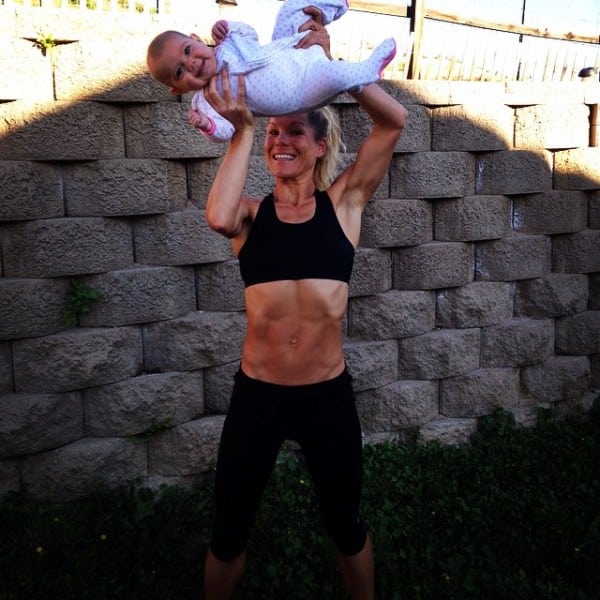
Michele and her baby, Maya, working out. Photo: Wyatt Yates
Meghan Arbogast

Meghan Arbogast
iRunFar: Give us a recap of what went down for you at last year’s WS 100. You finished eighth but had a lower-leg issue that caused some full-body listing as the race went on. What happened? And how the hell can you still finish in the top 10 despite this?
Meghan Arbogast: I turned an ankle six weeks before the race. I do that often, but never hurt them. This time was different. However, I ran Bishop 100k a couple of weeks later and had no problems. Then three weeks before States, Craig Thornley and I challenged each other in a road 5k. I won, but the price I paid was that my ankle was really jacked up afterward. I tried to ignore it first, then had a couple of folks play around with it before the race, but it was really unstable, and the joint was not moving properly. During the race I was on Aleve and Tylenol, but most every step was a somewhat painful. By the time I got to Michigan Bluff, my right side had been doing all the work, causing my hamstring to go into a massive cramp. I hardly ever, ever, ever cramp. And then by the time I got to the river, the leaning had started. From Green Gate in, my boyfriend/pacer Mark encouraged me every step of the way by saying, over and over again, “Just try to stay in the middle of the trail, Meghan.” At Highway 49, I looked like a drunken sailor. Crossing the finish line I tried so hard to lean the other way, but in the picture it is obvious that didn’t work.
Top 10, well, I got lucky, that’s what. I’m generally a very consistent runner, and without the lean I would put myself a couple hours faster. And sometimes a couple of hours faster is still eighth place. It just goes to show we can’t really control our place because we can’t control what our competitors do.
iRunFar: Eight WS 100 finishes. Why are you called back each year? What’s the draw for you? Obviously you are on the hunt for 10 top-10 finishes at this point. Is there a goal beyond? Or how about a smaller, more immediate goal?
Arbogast: This race is in my blood. If I don’t get in the race some day, I will be there doing whatever race management wants me to do, or pacing and crewing someone else. The race is a magnet for everything that makes me feel alive and that I belong to something. I find running exhilarating. I love being outdoors. I love dirt and trees and rocks and views. I love all the people that are here doing the same thing. I love how it lends itself to respecting your body, what you put in it, how you take care of it, how you LIVE in it.
Of course, competition-wise, I am drawn to see if I can make top 10 or top five or top one. I am so used to racing after all these years that I’m not super concerned about how my place moves up and down, but I am super curious about my 54-year-old body seeming to not be slowing down a whole bunch yet. So I want to keep going after the best performance I can put together. I feel like I’m a little science project. Oh, the goal beyond is fun… I want to be like Tim Twietmeyer. Twenty-five 24-hour finishes. Heee heee! I won’t give up until it I don’t make it!
iRunFar: You love this race and this part of California enough that you full on moved to it. You live every close to the course now. It’s definitely in your blood! What gets you fired up about it?
Arbogast: It is nice living and training here and being a part of the more immediate family and story of the race. With all of the miles of trails and training on them for so many months, by golly there better be a race at some point! I just get very excited by build up, all of the athletes from around the world to play in our backyard is quite a celebration.
iRunFar: You’re one of those runners that other people ‘mark.’ They look at you and think, Now here’s someone I should run with. She runs smart. I’m guessing you have a bit of a fan club/group of followers at times during races. What makes you a good ‘mark?’ Why are you so-darn steady with your WS 100 performances? This is a really hard race and distance!
Arbogast: It is funny how many men will pass me early in the race and say just that, and then when I pass them back they say they should have followed their own advice. I think I’m steady because I came into the sport very methodically. I ran road marathons for years, with good coaches. Then in ultras, I continued using the same methodical training and had good training partners who did the same. My mentor in the sport is Craig Thornley, and he has solid training practices. While I may not be getting faster, I can hone my skills and improve my endurance. And the more I do it the easier the distance gets in my head, which we know is the hardest muscle to get into shape.
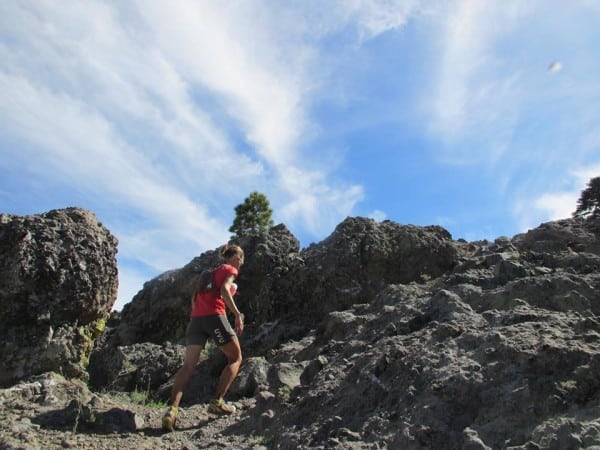
A cougar on the Western States Trail’s Cougar Rock. (That’s Meghan’s own caption!) Photo: Jeff Kozak
